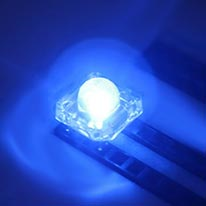Latest LED technologies and their applications in industry

LED technology has been around since the 1960s and today, it is used in a wide range of applications including industrial and residential lighting systems.
Recent advancements in LED technology have made them more efficient, durable, and versatile than ever before. In this article, we will discuss the latest achievements in LED technology and their applications in industry.
Firstly, let's talk about the latest developments in LED technology. One of the most significant achievements is the use of phosphor-based LEDs, which can produce a wider range of colors and higher quality white light. These LEDs use a phosphor coating to convert blue light to white light, resulting in a higher color rendering index (CRI) and more natural-looking light. Another important development is the use of gallium nitride (GaN) semiconductors, which can produce brighter and more efficient LEDs than traditional silicon-based semiconductors. This has led to the development of high-brightness LEDs that can be used for outdoor lighting and large-format displays.
Over the past few decades, the lighting industry has undergone a major transformation with the development of LED (Light Emitting Diode) technology. The latest advancements in LED technology have made it more efficient, longer-lasting, and more versatile than ever before. As a result, LEDs have become increasingly popular in various applications, including in the industrial sector.
One area where LED technology is being extensively used is in automotive lighting. LED headlights are becoming more common in new cars due to their long lifespan, energy efficiency, and high brightness. They are more reliable and durable compared to traditional headlights and provide better visibility to drivers, which enhances road safety. LEDs are also being used in traffic lights and streetlights, where their energy efficiency and long lifespan can result in significant cost savings for cities and municipalities.
In the industrial sector, LED lighting has been adopted as a reliable and efficient solution for a variety of applications, including warehouses, factories, and parking garages. The use of LED lighting in these facilities has led to significant energy savings and reduced maintenance costs. LED lights are also ideal for industrial applications due to their high resistance to shock and vibration, making them a durable and long-lasting option.
LED lighting is also being used in the agricultural industry to promote plant growth. Plants require a specific light spectrum for optimal growth and development, and LEDs can provide this spectrum more efficiently than traditional lighting sources. By using LED lighting, farmers can control the light spectrum to meet the specific needs of different crops, resulting in better yields and reduced energy costs.
LED technology is also being used in the aerospace industry. LEDs are ideal for use in space applications as they are durable, lightweight, and consume less power than traditional lighting sources. LEDs have been used in space missions to provide lighting for astronauts, and are also being used in spacecraft for navigation and signaling purposes.
In the mining industry, LED lighting is being used to improve safety and productivity. Mines are often dark and dangerous environments, and adequate lighting is essential to ensure the safety of workers. LED lighting is more efficient, longer-lasting, and provides better visibility than traditional lighting sources, making it an ideal solution for mining operations.
The use of LED technology is not limited to lighting applications. LEDs are also being used in the industrial sector for sensing and communication applications. LED sensors are being used in manufacturing processes to detect the presence of objects, monitor production lines, and perform quality control checks. LED communication technology is being used to transmit data wirelessly in industrial environments, improving communication between devices and enhancing automation processes.
In conclusion, LED technology has revolutionized the lighting industry and is being widely adopted in the industrial sector due to its energy efficiency, long lifespan, and durability. From automotive lighting to industrial applications, LEDs are being used in a wide range of applications, and as the technology continues to evolve, we can expect to see even more innovative uses in the future. The adoption of LED technology in the industrial sector will continue to improve safety, productivity, and energy efficiency, leading to significant cost savings for businesses and a more sustainable future.

